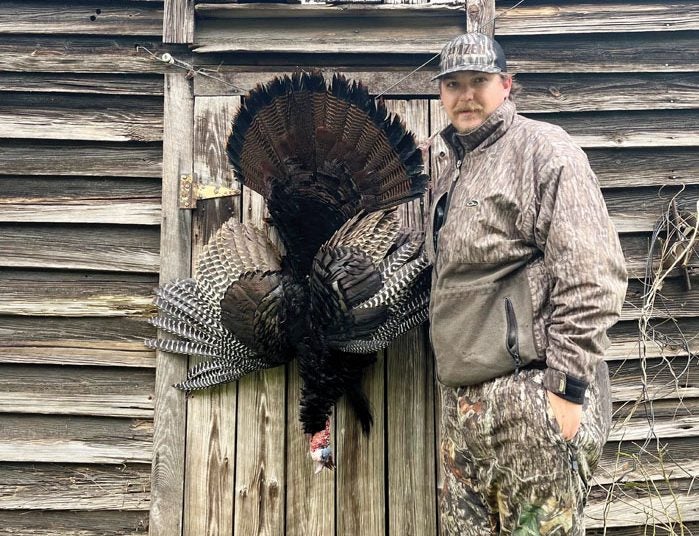Wanna step outside? The lowdown on turkey gobbling
Published 12:00 am Sunday, April 16, 2023

- John Weatherington of Mocksville killed this nice gobbler the afternoon of April 8, opening day of North Carolina’s spring turkey season, on a family farm in Davie County.
By Dan Kibler
About a month ago, some of the miscreants I consider fountains of hunting knowledge started talking — about one thing in particular.
“They’re gobbling; I heard them the other morning,” was a common theme.
Yes, when turkey gobblers start making the noise for which they are famous, it gets the blood of turkey hunters everywhere flowing like nothing else.
And for some of them, that’s a problem. I know that for a fact, because it was a problem for me the first handful of years that I hunted seriously for turkeys.
I loved hearing a big bird belt out a gobble too much.
When I decided I didn’t need to hear a bird gobble every time I called to him, I started killing turkeys.
First off, when gobblers are opening up at just about everything that makes a loud noise, it’s probably too early to be hunting them. That was the thing that made Mike Seamster, who was the N.C. Wildlife Resources Commission’s turkey biologist for decades, set the season’s opening day when he did — the second Saturday in April.
He wanted to get the state’s turkeys past their first peak of gobbling before letting a camouflaged army start sending loads of copper-plated No. 4s — or in my case, TSS No. 9s — in their direction.
His explanation? When tom turkeys are gobbling the most, they are doing the most breeding, and they have the attention of most of the hens in the woods. Right off, we have to agree that it’s tough to kill a gobbler who has hens crowded around him. Second, you need to wait to kill him until after he’s bred most of those hens.
That’s why North Carolina’s season opener is, for example, one to two weeks later than South Carolina and Georgia.
Once plenty of hens have been bred — after a couple of weeks — tom turkeys go gobbling again: the second peak of gobbling. Seamster tried to set up the dates for North Carolina’s spring turkey season to take advantage of that second peak of gobbling, when there were less hens around to compete with your yelps, clucks and purrs. Because calendar shifts can put the second Saturday as early as April 8 (as happened this year) or as late as April 15, where that second peak falls matters.
When the season opened, say, April 12 or earlier, Seamster expected the second week of the season to be the most productive. When it opened later, the first week of the season would be the bomb.
My experience bears that out. In the handful of years when I’ve killed an opening day bird, it was when the season opened later. Birds I’ve killed a week or two into the season have usually coincided with an early opening day.
That takes care of timing, now, on to the problems involved with loving to hear birds gobble.
I’ll admit, there’s nothing like it in the world, sitting with your back up against a big beech tree before dawn and hearing a bird belt out a throaty hello from a tree a hundred or so yards away.
The problem early in my hunting career was that I wanted to hear them gobble all the time. So if I got a bird gobbling, I wanted him to keep gobbling all the way to the end of my gun barrel, so I’d call too much, trying to get him to gobble repeatedly. Typically, that bird would come in a way, then stop, and when I kept pouring it to him with a box or mouth call, he’d eventually turn and walk away, gobbling every couple of minutes. When I tired of hearing turkeys gobbling while leaving my area, I realized calling so much and not getting toms into range must have been related.
And I started killing more turkeys.
Marshall Collette of Greensboro, a pro staffer for Quaker Boy calls and Mossy Oak camo, understood. He’s a firm believer in the concept that oftentimes, less is more.
“When you’re calling a turkey,” Colette said. “You’re reversing nature. The hen usually comes to him; you’re trying to make him come to you. He’s gonna come as far as he thinks he needs to, to where he should be able to see his girlfriend, and then he’ll stop.”
I had that happen in South Carolina two weeks ago. I called a bird off the roost, across a half-mile-wide swamp, and he stopped 60 yards away, behind a bank of palmettos. He stayed there 5 minutes, gobbled three or four times, then walked off, gobbling as he went back to the other side of the swamp. He didn’t see a hen and didn’t trust that there was one waiting for him — only me, blinded in at the base of a big pine tree, 12-gauge in hand.
Colette believes that loud calling to locate a bird is perfectly acceptable. But once he gobbles a couple of times and expresses interest, a hunter should go quiet, calling only enough to let a tom know where you are — not elicit another gobble.
“When he hits the ground, you want to let him know you’re there,” he said. “The closer he gets, the quieter you call. Most hunters want to call ‘til they can see him, then shut up. I want to quit calling before I see him, and I don’t want to see him until he’s in range.
“If a turkey hangs up there, out of range, it’s often because you called too loud and too often.”





